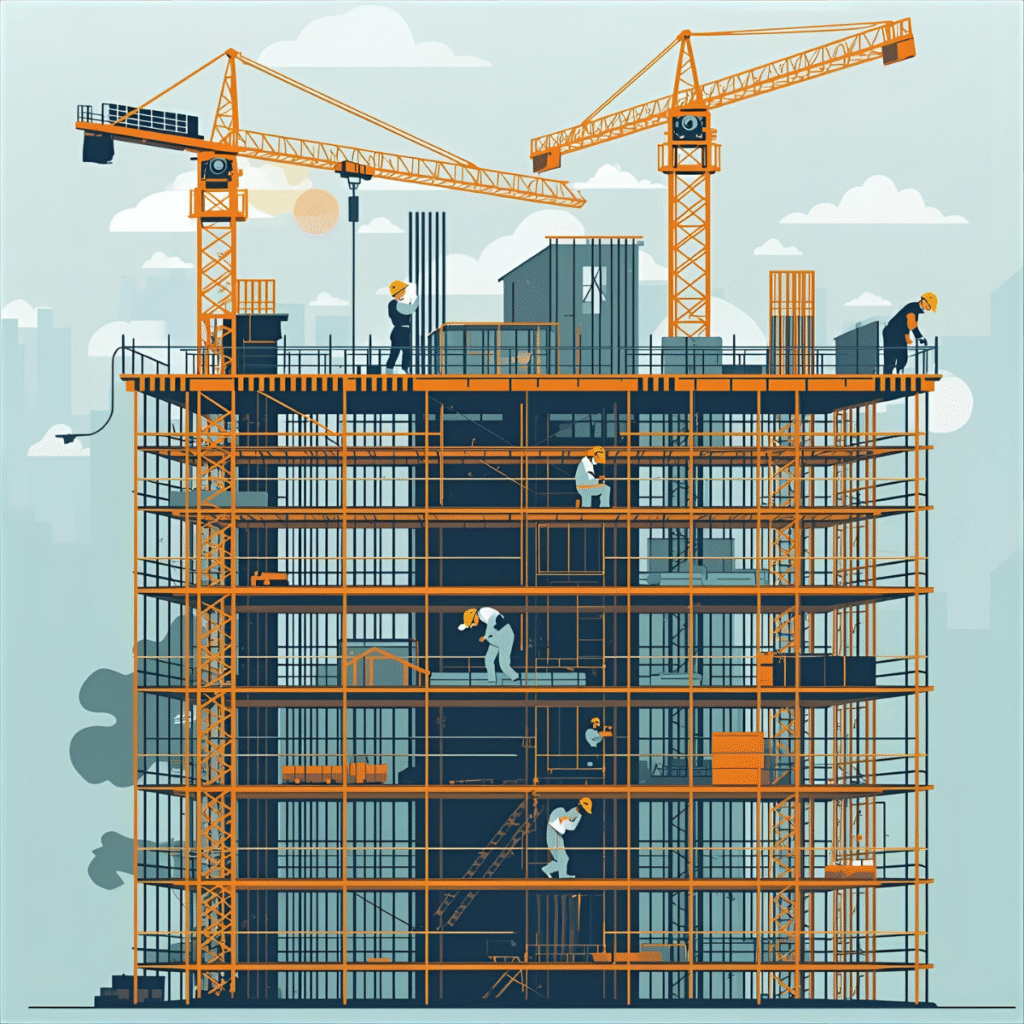In the world of construction, time is money. Every delay not only increases costs but also disrupts schedules, creates stress for clients, and damages the reputation of contractors. A project that was meant to finish in 12 months often stretches into 18 months—or more—simply because of mismanagement, lack of planning, or unforeseen challenges. For homeowners, this means additional rent payments, higher interest on loans, and delayed possession. For builders and contractors, it means stretched budgets, increased labor costs, and unhappy clients.
But construction delays are not inevitable. By identifying the root causes and adopting smart planning methods, both contractors and clients can significantly reduce delays. Whether you’re hiring a construction company in Lucknow, planning a small residential project, or managing a large commercial development, the principles are the same: proper planning, clear communication, timely approvals, and efficient execution are the keys to saving time.
Why Do Construction Delays Happen?
Before we learn how to reduce them, it’s essential to understand why delays occur in the first place. Construction projects are complex, with multiple teams, stages, and dependencies. A small misstep at one stage often snowballs into significant delays later.
Some of the most common reasons include poor planning, late delivery of materials, lack of labor, bad weather, design changes, and unexpected site conditions. In places like Uttar Pradesh, where urban expansion is rapid, construction companies also face regulatory hurdles and delays in getting approvals.
For example, if a homeowner in Lucknow decides mid-project to change their kitchen layout, the new design could delay plumbing, electrical work, and even flooring installation. Similarly, if a contractor fails to arrange cement deliveries on time, the entire site comes to a standstill.
Smart Planning – The Foundation of Timely Construction
Planning is the most crucial factor in construction. A well-planned project considers not only timelines but also materials, manpower, approvals, and contingencies. Before laying the first brick, contractors should create a detailed project schedule using tools like Gantt charts.
Let’s take an example. Imagine a residential project in Gomti Nagar, Lucknow, planned to finish in 10 months. If the contractor doesn’t map out when the electrician, plumber, carpenter, and painter are supposed to come in, chaos will follow. Instead, if each stage is allocated a specific timeline with buffer periods for delays, the chances of finishing on time are much higher.
Homeowners can also contribute by being decisive during the planning stage. Instead of making last-minute changes, they should finalize designs, budgets, and requirements well in advance.

Importance of Timely Approvals
One of the biggest roadblocks in construction is paperwork. Without the right approvals, work often gets stalled. For example, in urban centers like Lucknow, construction companies must obtain building permits, environmental clearances, and safety certificates before starting major projects. Delays in these approvals can add months to the timeline.
To avoid this, a proactive approach is necessary. Contractors should start paperwork early, communicate clearly with local authorities, and ensure compliance with building codes. Homeowners should also check if their chosen contractor has experience in handling local regulations, as a company familiar with the system can often fast-track approvals.
Managing Materials Efficiently
Delays in material supply are among the most common causes of time overruns. Cement, steel, tiles, or wood arriving late can bring work to a halt. In some cases, poor quality materials may also lead to rework, causing further delays.
The solution lies in efficient procurement planning. Contractors should create a timeline of when each material is required and place orders well in advance. Partnering with reliable suppliers is also critical. For example, if a construction company in Lucknow consistently sources from the same vendor, they are likely to get priority delivery, even during high-demand periods.
In addition, using technology like inventory management software helps track materials, avoid shortages, and ensure timely deliveries.
Skilled Workforce and Labor Management
Even with the best materials, a project cannot move forward without skilled workers. Delays often occur because of labor shortages, mismanagement of workforce, or lack of skilled professionals.
Hiring the right mix of skilled and semi-skilled labor is essential. Contractors should also ensure workers are trained in safety and efficiency, reducing accidents and rework. A well-managed workforce works faster and delivers higher-quality results.
In practical terms, this could mean assigning clear daily targets, maintaining attendance logs, and creating an incentive system for timely completion. For example, offering bonuses to workers who meet weekly deadlines can keep morale high and productivity consistent.
Clear Communication Between All Parties
Another major reason for construction delays is miscommunication. If the architect, contractor, and client are not on the same page, the project suffers. For instance, if the architect sends a revised house map but the contractor continues with the old plan, weeks of work may have to be redone.
The solution is regular meetings and updates. Weekly progress reports, site visits, and digital tools like WhatsApp groups or project management apps can keep everyone aligned. Clear documentation of instructions also prevents confusion.
Weather and Environmental Factors
Weather is an unpredictable factor that affects construction timelines. Heavy rains, extreme heat, or flooding can bring outdoor work to a standstill. In places like Uttar Pradesh, monsoon often delays projects significantly.
While weather cannot be controlled, it can be planned for. Contractors should factor in local weather conditions while creating schedules. For instance, outdoor foundation work should be planned outside the peak monsoon months. Building in buffer periods for weather-related stoppages ensures the overall project timeline stays realistic.

Avoiding Design Changes Midway
One of the most frustrating causes of delays is frequent design changes. Clients often request modifications after construction has already started—like shifting a bedroom wall, changing bathroom tiles, or expanding the kitchen. Each change disrupts the schedule, increases costs, and sometimes even requires re-approvals.
To reduce this, clients should finalize their house maps, interior layouts, and materials before construction begins. Contractors, on their part, should create realistic 3D models and walkthroughs for clients. This allows homeowners to visualize their project beforehand, reducing the chances of last-minute changes.
For example, a 3D interior design service in Lucknow can show how a modular kitchen will look, allowing clients to confirm or adjust the design before the actual construction begins.
Use of Technology in Reducing Delays
Modern construction increasingly relies on technology to save time and reduce errors. Project management software helps track progress, drones assist in site monitoring, and Building Information Modeling (BIM) ensures accurate planning.
For example, BIM allows contractors to create a digital replica of the building, highlighting potential conflicts between plumbing, electrical, and structural elements before construction even begins. This proactive approach prevents rework and ensures smoother execution.
Financial Planning and Payment Schedules
Construction delays are often linked to money. If clients fail to release payments on time, contractors may not be able to pay workers or suppliers, bringing work to a halt. Similarly, poor financial planning by contractors can result in cash flow problems.
A transparent payment schedule agreed upon at the start helps avoid such situations. Clients should ensure funds are available for each stage of work, while contractors should keep proper records of expenses and avoid unnecessary overspending.
The Role of Quality Control
Sometimes, delays occur because of poor quality work. If a wall is built incorrectly, it may need to be broken down and rebuilt, wasting precious time. Regular inspections and quality checks ensure mistakes are caught early before they affect the timeline.
For example, checking the curing of concrete, alignment of beams, or waterproofing of bathrooms at the right time avoids costly rework later. Contractors should also use checklists to ensure each stage is properly completed before moving forward.

Practical Tips to Reduce Construction Delays
While most of the strategies we’ve discussed involve detailed explanations, here are some key points to keep in mind:
- Plan thoroughly before starting work.
- Finalize designs and budgets early.
- Choose reliable suppliers and order materials in advance.
- Hire skilled labor and manage them effectively.
- Maintain regular communication between all stakeholders.
- Factor in weather conditions when scheduling.
- Stick to approved designs and avoid mid-project changes.
- Use modern technology for planning and monitoring.
- Ensure timely payments and proper financial planning.
Conduct regular quality checks to prevent rework.
Conclusion
Construction delays are not just inconvenient—they are costly, frustrating, and sometimes damaging to both clients and contractors. However, with smart planning, clear communication, timely approvals, efficient labor and material management, and the right use of technology, delays can be minimized.
For homeowners, this means moving into your dream home on time without additional financial strain. For contractors, it means satisfied clients, better reputation, and improved profitability.
Whether you are working with a construction company in Lucknow or managing your own project, the principle remains the same: build smart, build strong, and build on time.
